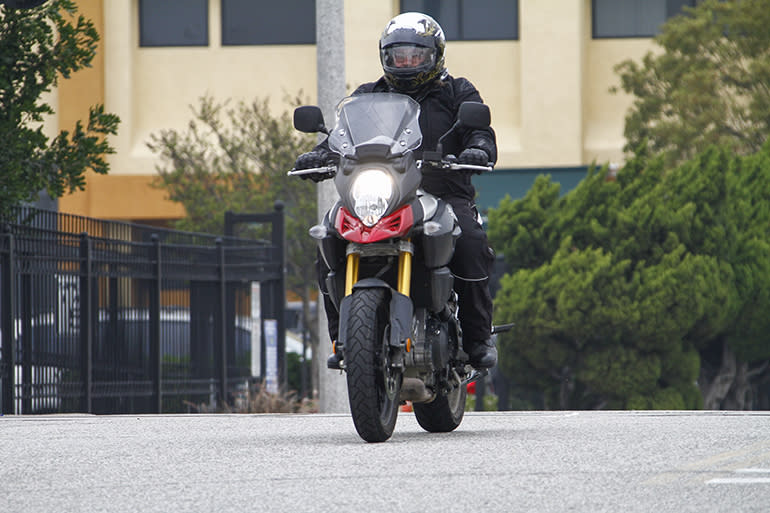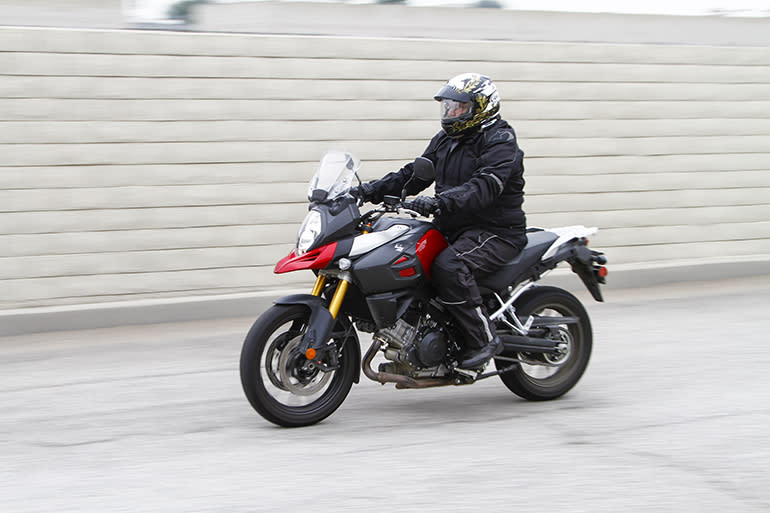RideApart Review: 2015 Suzuki V-Strom 1000 ABS
I’m always searching for a bike that can do everything. Ever since I first rode an adventure bike back in the 1990s (a Triumph Tiger 900), I’ve been convinced that the tall, slim, athletic bike was the ticket. On an adventure bike, I can commute, lane share (in my home state of California), tour, and even do a little bit of dirt road exploration. Adventure bikes are the Swiss Army knives of motorcycling. Maybe they’re not the best at any one task, but they are so useful right out of the box that it seems petty to complain about the plastic toothpick.
The Suzuki V-Strom has had my attention ever since its debut in 2002 as the DL 1000 V-Strom. The V-Strom 650 joined the lineup in 2004, and benefited from a major makeover for 2012. 2014 was the V-Strom 1000’s year for a major update that touched virtually every aspect of the bike. I got a chance to spend some time with the 2015 V-Strom 1000 ABS, plugging it into my routine as my everyday motorcycle for over a month.
MUST READ: 5 Under 5: The Nest Sub-$5,000 Motorcycles For 2015 RideApart
Drawing another analogy, adventure bikes are a lot like SUVs. You have to drive an SUV before you can evaluate or appreciate its appearance – SUVs rarely win design competitions, and they don’t generally turn heads in stock form. But spend some time in a good SUV, like a Toyota 4Runner for instance, and you begin to appreciate the way those slab sides aid in maneuverability, and how that flat hood helps you to judge the distance between your grille and an obstacle. Over time, this appreciation of function turns into an appreciation for form – at least it does for me.

The same thing happened with the V-Strom and me. At first, its tall stance, stacked headlights and beak looked odd and gangly to me. I didn’t fully appreciate its lack of ornamentation, seeing its matte surfaces and plastics as ordinary. In time though, the looks grew on me because the bike possesses a ruggedness that isn't flashy. It shows off its most important component, its engine, and makes no effort to hide its frame and subframe behind body panels. A simple LCD and analog dash gives all the information necessary–nothing extra. A convenient weather-sealed 12-volt outlet lives right below the dash. This is an honest bike, with maintenance parts (oil filter, chain) easily accessible and neatly displayed. Form following function is its own kind of beauty.

Engine
A fuel-injected, liquid-cooled V-Twin engine powers the V-Strom 1000 ABS, and it displaces at 1,037cc. Suzuki doesn’t release horsepower or torque figures, but most sources have rated the engine at about 90 hp and 67 lb-ft of torque. Peak horsepower arrives at around 8,200 rpm, torque hits 50 at about 2,000 rpm, and ramps up to peak at about 3,800. In real world terms, that means that the bike pulls smoothly off of idle, especially with the new slipper clutch, and builds momentum predictably right up the line.
I noticed that off-idle throttle was a little tricky, requiring a smooth hand to avoid a jerky start. With practice and familiarity, I was able to conquer this and could live with it. A dyno tune and ECU flash would probably be a good experiment for owners. With a six-speed transmission and chain final drive, there’s plenty of latitude to shift according to your own riding style. In heavy traffic, the torque curve allows for minimal shifting between the lower gears, and power to pass and squirt through traffic is always on tap. When the road eventually opens up, you can shift into the upper gears for lower revs and a smoother ride. It’s a very smooth ride, and with the stock 2-into-1 right side exhaust, the V-Twin growls at a nice pitch. This isn't an engine that demands close attention to the tachometer. You can just ride it by sound and feel, and have the confidence that the right gear is always close by.

The Ride
Riding the V-Strom proved to be truly enjoyable. We had an unexpected period of rain here in Southern California during February, and I had the opportunity to take the V-Strom out on the highway several times in downpours (not always by choice). The 19” front/17” rear wheels were wrapped with Bridgestone Battle Wing rubber that were most suited to the road, and performed well in the wet. The stock windscreen is manually adjustable for three angles of tilt, and can be moved with tools into upper and lower positions. I discovered that the upper position and minimum tilt provided the best wind protection, with minimal buffeting of my helmet. The tiny fairing and shield didn’t do a great job of keeping me dry, but I didn’t expect that anyway. I think that the beak and front fender split the road spray away from me because my body and legs didn’t get overly saturated with dirt.
MUST WATCH: Honda BULLDOG Unveiled - Would You Ride It? | RideApart
In nicer weather, I spent some time on the back roads and canyons just riding for fun. I had no problems with cornering clearance, even though the foot pegs are rather low. The V-Strom is eager to lean into turns and tracks beautifully on a smooth road. Rougher stuff doesn’t upset the bike either since the suspension soaks up the bumps.

On longer rides, the seating position was just right for me at 6’2” with a 32” inseam. I was never cramped, never tired, and only started to think about the seat after about 100 miles in the saddle. I didn’t spend much time riding with a passenger because the tall rear seat intimidated my wife, who stands at 5’3.” She took one look at it and decided that she’d wait until the next cruiser or touring bike rolled around.
The V-Strom’s fuel capacity is 5.3 gallons–down a bit from the previous generation’s capacity. I averaged a little over 42 miles per gallon during my time on the bike, which puts the V-Strom’s range at over 200 miles.
Chassis/Suspension
The V-Strom’s chassis felt very rigid and didn't introduce any anomalies into its handling. Gold-anodized front forks are the inverted telescopic type with coil springs and oil damping with no adjustability. The rear suspension is a link type with a single oil damped coil spring that is manually dial-adjustable for preload. Travel is long on both ends, as typical of this style of bike. Twin disc brakes handle the stopping in the front, and a single disc works on the rear.

 Yahoo Autos
Yahoo Autos 
